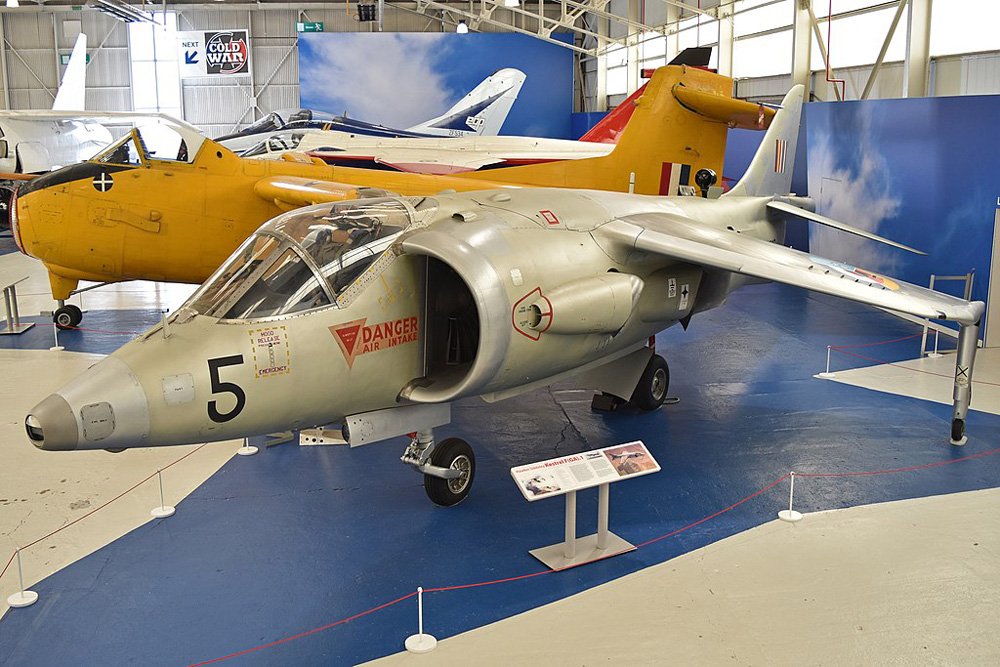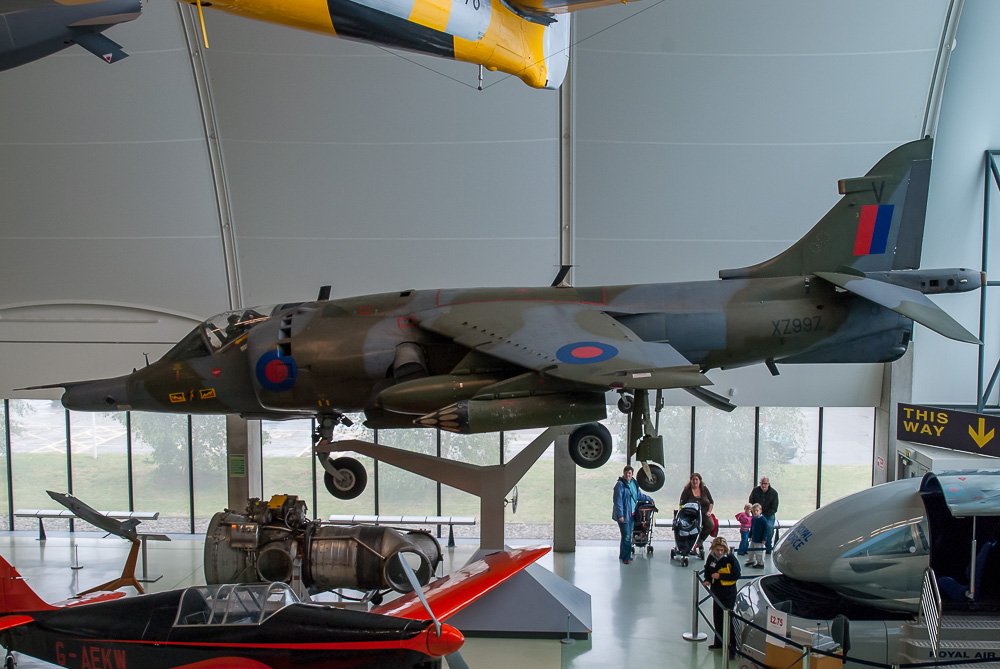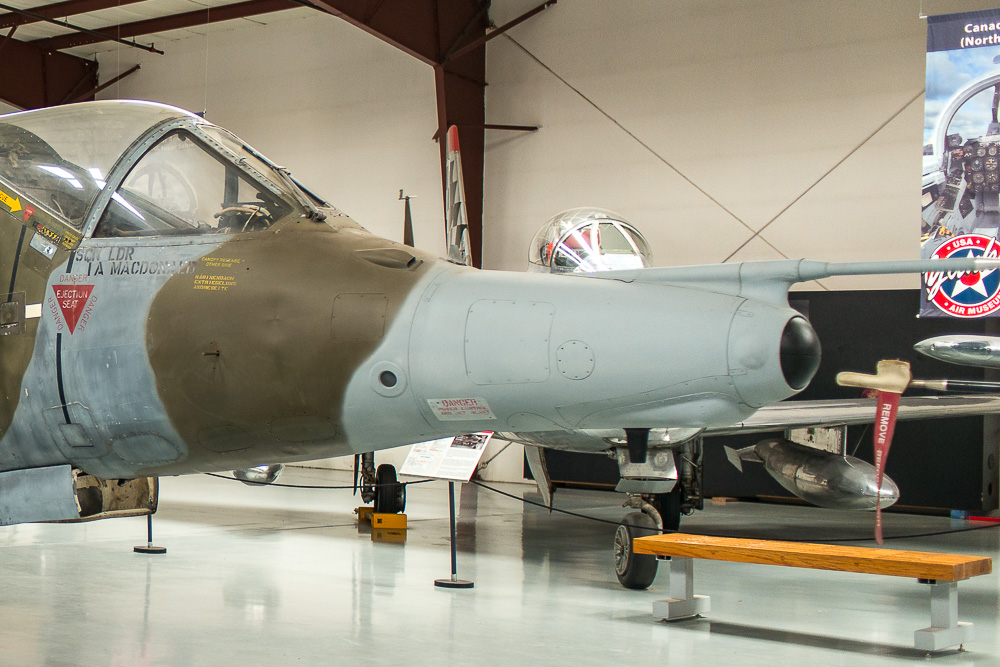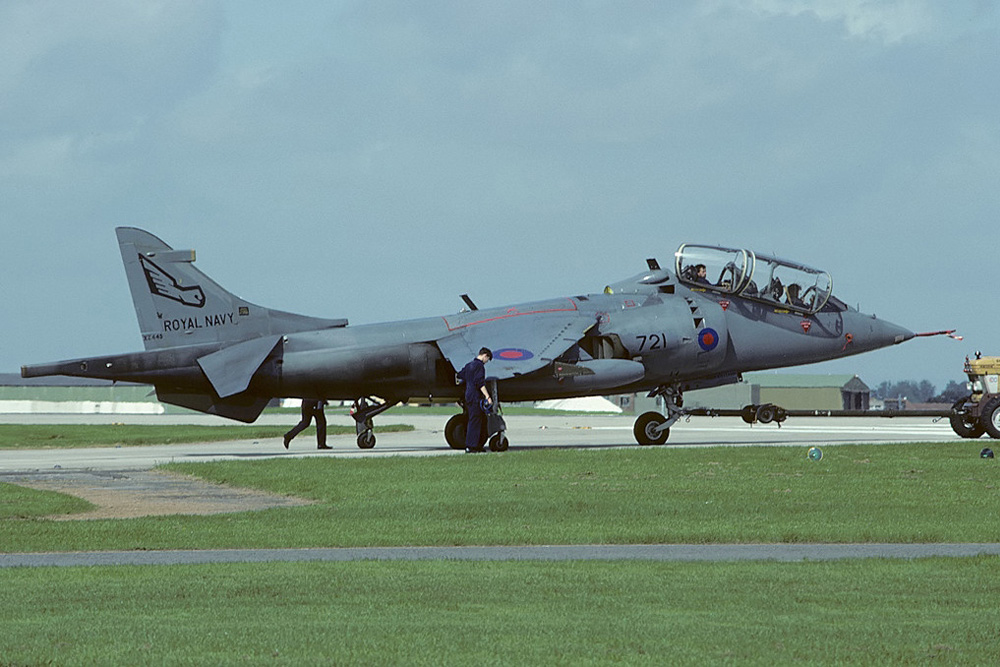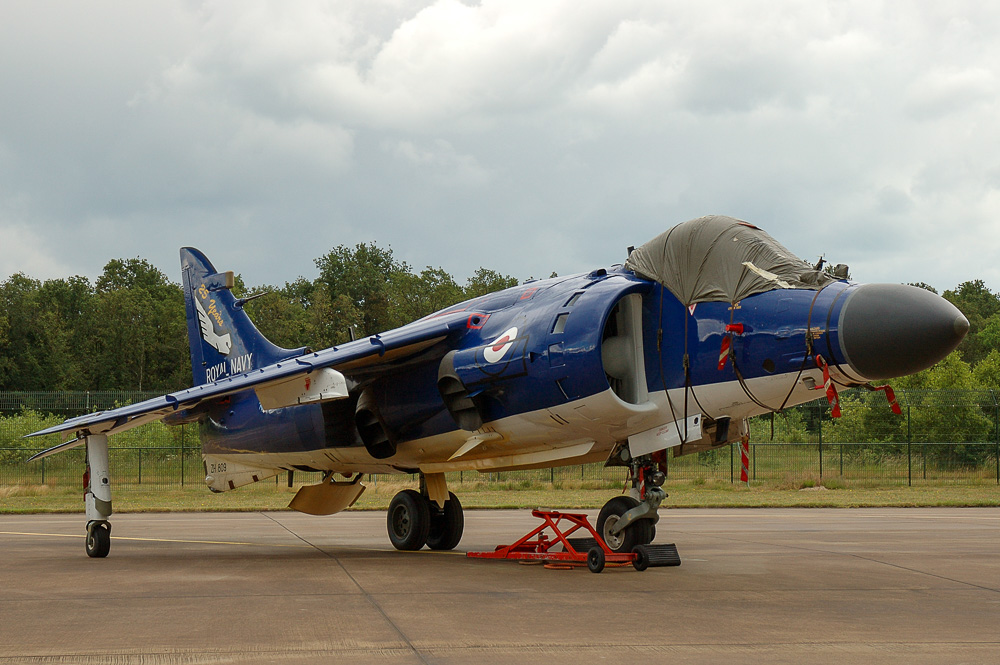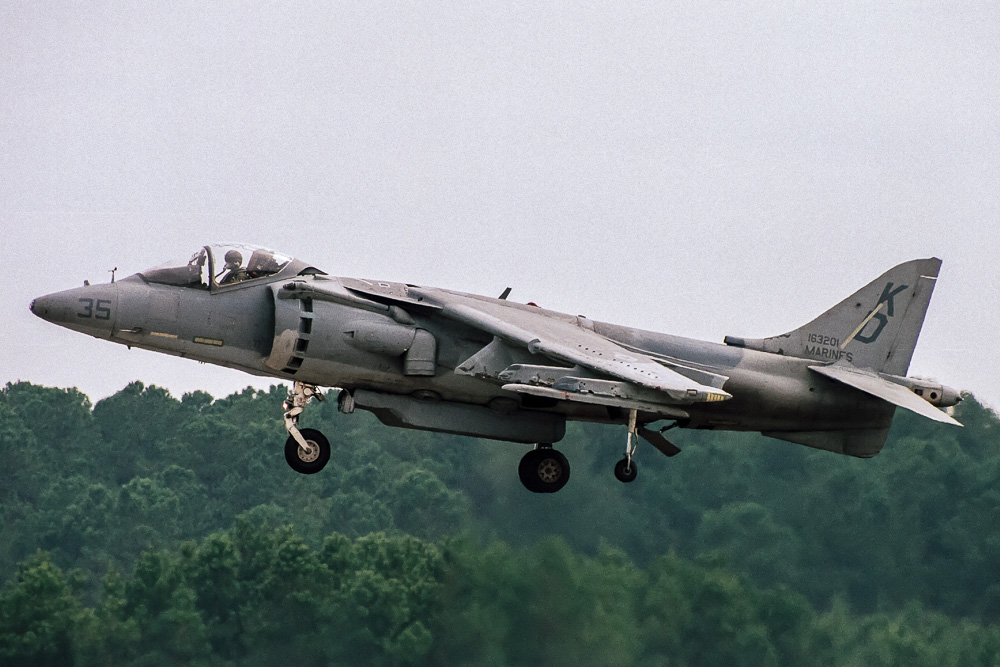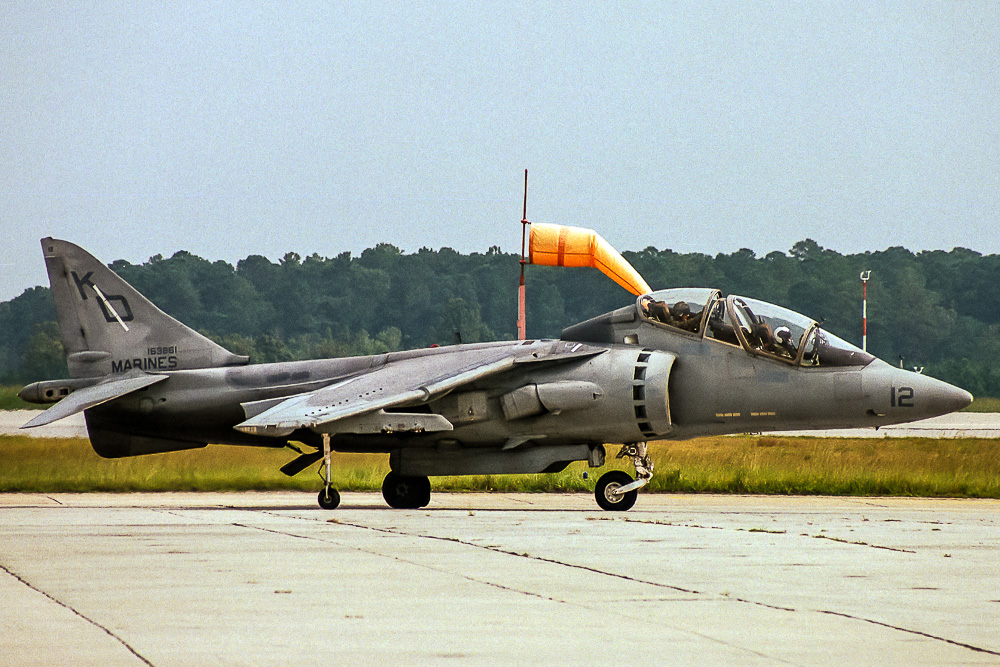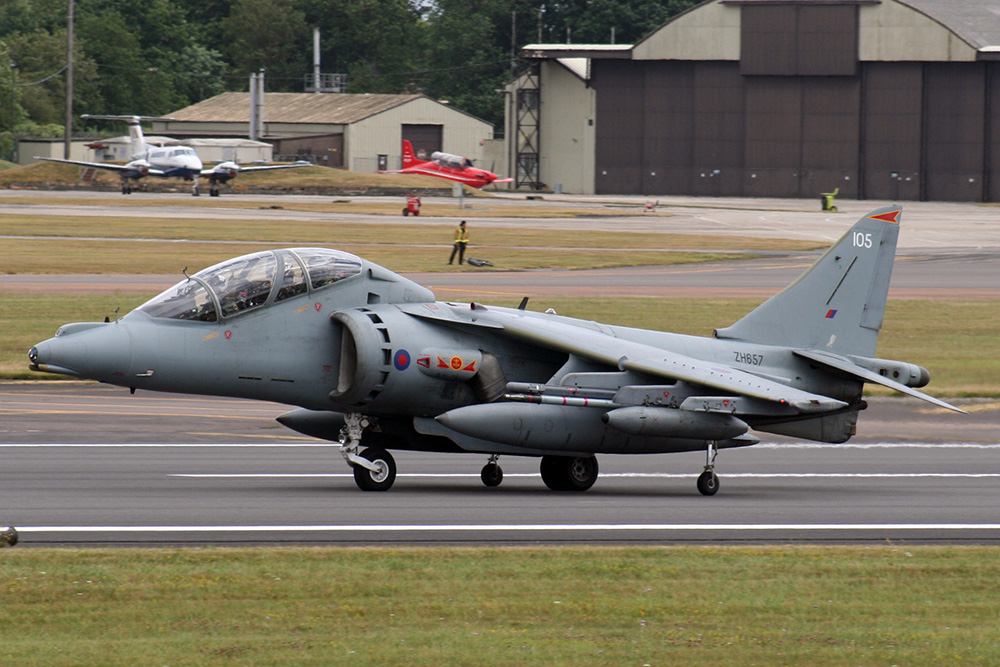
Hawker/Hawker-Siddeley/British Aerospace/McDonnell-Douglas Harrier family
To reduce the reliance on long runways in the 1950s many aircraft manufacturers sought to design a fighter jet with the ability to take-off and land vertically, a so-called VTOL or V/STOL aircraft. Hawker-Siddeley became the first to create a useful jet fighter that set the (western) standard for many decades. Only from the 2010s they start to be replaced by the F-35B.
We are talking about the famous Harrier jump jet, that originates from a development aircraft called P.1127. Two generations followed on both sides of the Atlantic. The Harrier is powered by a Rolls-Royce Pegasus engine in the middle of the fuselage. It is fed by two big semi-circular intakes at the sides of the fuselage. Below the high mounted wings are two sets of nozzles that can swivel 90 degrees from straight back to straight down. These exhausts leave no room for a conventional landing gear, so the Harrier has a single two wheel main landing gear, a single wheel nose gear and two small stabilising wheels near the wing tips. The tail is conventional with as characteristic a curved leading edge over the top of the vertical stabiliser, and horizontal stabilisers with significant anhedral.
Here you see two key features of all Harrier versions, including predecessors: the two swivelling nozzles at the side and the single two wheel main landing gear.
The Harriers have a tail similar to that of the Hawk training aircraft, with a curved leading edge of the vertical stabiliser, all the way over the top, and horizontal stabilisers with significant anhedral.
Different versions
The different versions of the Harrier family can be distinguished by:
- the shape of the canopy
- the location of the stabilising wingtip landing gears
- the shape of the wingtips
- the shape of the air intakes
- the presence of an half oval plate in front of the air intakes
- the presence and length of an air intake in the dorsal fin
- the sweep angle of the trailing edge of the wings
- the shape of the nose
- the shape of the swivelling nozzles
- the height and shape of the vertical stabiliser
- the presence of leading edge root extensions
More details to follow.
Hawker P.1127
Six P.1127 development aircraft were built, that already differed amongst each other, a result of continued development. All except one had wings with a non-swept trailing edge. The last P.1127 had a swept trailing edge, like on all subsequent aircraft. Also most P.1127s had a long boom at the tip of the nose, but some were converted with the blunt camera nose of the Kestrel. The vertical stabiliser originally had a rudder all the way to the top, but on some aircraft the fin was made taller, meaning that the rudder ends slightly below the top. Finally, the horizontal stabilisers originally had no anhedral, but later P.1127s had.
Common between all P.1127s was the half oval plate in front of the air intake, below the canopy. The intake itself is slightly canted, when viewed from above. The stabilising gears are placed at the very edge of the wingtip. The streamline body for these wingtip gears extends to in front of the leading edge.
A P.1127 development aircraft recognisable by the long pointed nose boom, air intakes and wingtip streamline body for the outrigger gear partly in front of the wing leading edge. (photo: Alan Wilson/WikiMedia)
The flat side plate in front of the air intake with a half oval contour, below the canopy, is a key feature of the P.1127. Also the intake lacks any rectangular doors around it.
Kestrel FGA1 & XV-6A
For further evaluation in the UK and USA nine improved versions were built and extensively tested. These are designated Kestrel FGA1 (FGA Mk.1) with the Royal Air Force and XV-6A by the US military (although VZ-12 was reserved).
The Kestrel differs from the P.1127 by having air intakes nearly perpendicular to the side of the fuselage, with no plate in front of them. The instrumentation boom is now placed in front of the vertical stabiliser, leaving the nose to a forward looking camera, making the nose more blunt. The streamline body for the stabilising gears does not extend in front of the wing leading edge anymore. Finally, the Kestrel/XV-6A has long strakes at the bottom of the fuselage, between the air intakes and main landing gear.
The Kestrel FGA1 has a slightly blunt nose with a camera. Also the stabilising gears at the wingtips have no bullet fairing in front of the leading edge. (photo: Alan Wilson/WikiMedia)
The air intakes of the Kestrel still have no doors around the edge, but the flat plate in front of it is gone. Note the long, thin strakes at the bottom of the fuselage. (photo: Clemens Vasters/WikiMedia)
Harrier GR1, Harrier GR1A & AV-8A
While externally largely similar to the Kestrel, the Harrier is actually a newly designed aircraft. There are still enough features to distinguish the Harrier from the Kestrel. First of all, the wingtip are more rounded and the stabilising gear it not at the outer end of the wings anymore. Secondly the first generation Harriers have a row of so-called 'suction relieve doors' near the leading edge of the air intake that can be opened to provide more air to the engine during hover. The nose is pointed again, with the camera moved elsewhere. Furthermore, they have a small intake at the root of the dorsal fin. The leading edge of the vertical stabiliser is uninterupted. Finally, they have storage points under the wings and fuselage. The canopy remains flush with the top of the fuselage.
This description concerns the Harrier GR1. The AV-8A is the designation for the US Marine Corps version, that is essentially the same, but has some customisation inside. The factory designation was Harrier Mk50. Finally, the Harrier GR1A has a different engine, but this is likely not visible from the outside.
This US Marine Corps AV-8A shows the features of the first generation Harrier: a pointed nose with boom, an uninterupted curved leading edge of vertical stabiliser with intake at the root and a canopy flush with the top of the fuselage.
The AV-8A has no antenna in the wingtip, the way to recognise it from the AV-8C.
On this detail photo of the AV-8A nose you can see the 'suction relieve doors' around the edge of the air intake that all Harrier versions have, unlike the P.1127 and Kestrel.
AV-8S Matador
The Spanish navy ordered the AV-8A in the United States, and called it AV-8S Matador. Externally they differ from the standard AV-8A by an extra antenna on top of the fuselage. Later, all were equipped with a radar warning receiver antenna at the top of the vertical stabiliser, in the leading edge (like on the Harrier GR3). By the manufacturer this version is known as Harrier Mk55.
The Spanish AV-8S is externally the same as the AV-8A except for the antennas on top of the fuselage and at the top of the vertical fin.
Harrier GR3
The first major upgrade of the Harrier involved adding radar warning receivers, one in the tail cone and one at the top of the vertical stabiliser (see photo of AV-8S above). Also a laser targeting device was mounted in a longer nose. This version was designated Harrier GR3, or GR Mk3.
Harrier T2, Harrier T2A, Harrier Mk52, TAV-8A & TAV-8S
When the Pegasus engine became powerfull enough Hawker-Siddeley made a two seat version of the Harrier, designated Harrier T2 by the Royal Air Force. It features a stretched forward fuselage with a tandem canopy. To improve stability the vertical stabiliser was made 18 inches taller. For the rest it is similar to the GR1. With the same engine as the Harrier GR1 Hawker created the Harrier T2A.
TAV-8A is the US military designation for the basic tandem cockpit version, known as Harrier Mk54 by the manufacturer. Similarly TAV-8S is the Spanish version, Harrier Mk58.
Finally the Harrier Mk52 was a civil registered demonstrator that was externally the same as the Harrier T2 but with a different engine and additional civil avionics.
The basic tandem seat Harrier, here the TAV-8S is shown, has of course a longer forward fuselage with longer canopy. Also the vertical stabiliser is significantly higher than that of the single seat Harrier.
From this angle you can better appreciate the taller fin of the two seat Harrier. This is the only Harrier Mk52 built. (photo: Mike Freer/WikiMedia)
Harrier T4
This is the two seat version of the Harrier GR3. So compared to the Harrier T2 it has the longer 'laser' nose and the RWR antenna in the tail.
The Harrier T4 has the longer nose of the Harrier GR3, as well as the radar warning receivers in the tail and tail cone. (photo: Mike Freer-Touchdown Aviation/WikiMedia)
Harrier T4A, Harrier T4N, Harrier T8 & Harrier Mk60
When the Fleet Air Arm got the Sea Harrier they first lend some two seat trainers from the Royal Air Force. These are known as Harrier T4A, differing from the standard T4 by different avionics and a lack of laser nose. The Harrier T4N was the dedicated trainer version for the Royal Navy, externally the same as the T4A. When the Harrier TN was updated with Sea Harrier F/A2 avionics it became Harrier T8. However, externally it seems not changed. Harrier Mk60 is the version of the Indian Navy, used to train Sea Harrier FRS51 pilots.
The Harrier T4A has the pointed nose of the Harrier T2 but the radar warning receiver antenna of the Harrier T4 in the tail. (photo: Mike Freer-Touchdown Aviation/WikiMedia)
Sea Harrier FRS1 & Sea Harrier FRS51
The main difference between the land based Harrier GR1 and the Sea Harrier is the higher, bubble canopy. Additionally, the nose is somewhat longer and wider, but still pointed. The pitot tube is now placed on top of the nose. The FRS1 version was used by the Royal Navy, the FRS51 by the Indian Navy.
Sea Harrier F/A2
Based on experience obtained during the Falkland War the Sea Harrier received a different radar. This radar is housed in a wider diameter nose, so this is the main recognition point of the Sea Harrier F/A2. The nose job also meant that the pitot tube was moved to the leading edge of the vertical stabiliser.
The bigger nose of the Sea Harrier F/A2 is obvious on this photo. Also note the pitot tube on the leading edge of the vertical stabiliser.
AV-8C
As an interim solution until the arrival of the AV-8B McDonnell-Douglas upgraded the AV-8A with radar warning receivers in the wingtips, chafe/flare dispensers and the flap between the longitudinal strakes, to increase the ground effect.
YAV-8B
To study possible upgrades to the Harrier McDonnell-Douglas built two YAB-8B development aircraft. They basically have the fuselage of the AV-8A with several features of the eventual AV-8B. The wings have a wider span allowing more storage points, and a different airfoil. To enhance manoeuvrablility on the ground the stabilising wheels were moved inward, closer to the fuselage. Around the air intake are two rows of rectangular 'suction relieve doors'. The exhaust have changed as well: no visible guide vanes anymore (see photo below the general description) but a single pipe. Finally, a cross-dam flap was added behind the nose gear that is extended when in hover close to the ground; it increases the ground effect caused by the the reflection of the vertical thrust, together with the longitudinal lift improvement devices (LID).
The YAV-8B showing the new wings with outrigger gears moved inward, the changed exhausts and double row of 'suction relieve doors'. (photo: NASA/WikiMedia)
AV-8B Harrier II & EAV-8B
The eventual production version of the YAV-8B has a redesigned fuselage, on which the canopy is made bigger and is raised like on the Sea Harrier. The nose is more blunt though. Additionally, the AV-8B has a single row of rectangular doors around the air intake. The longitudinal lift improvement devices are made larger (but can be replaced by gun pods). Finally, the Harrier II has leading edge root extensions (LERX) of the wings, on top of the air intake.
EAV-8B is the Spanish designation for the AV-8B.
AV-8B Harrier II (night attack)
To improve the operational effectiveness of the AV-8B a dedicated night attack variant was developed. It has additional sensors in the nose. One is placed between the canopy and the tip of the nose, the other in the tip itself.
From the front you can see the additional sensors of the night attack version of the AV-8B, one in the tip of the nose and one between the tip and the canopy. (photo US Navy/WikiMedia)
AV-8B+ Harrier II
The final US version of the Harrier II is an upgrade of the AV-8B, called AV-8B+. This versions has a different radar in the nose, requiring a nose job like on the Sea Harrier F/A2. The nose is more pointed than the other AV-8B versions, and retains a sensor on top of the nose, in front of the canopy. Finally, the air intake in the dorsal fin is longer than previous versions. A photo of the AV-8B+ is at the top of this page.
TAV-8B
The Harrier II got a trainer version as well, designated TAV-8B. It has a longer forward fuselage with a tandem canopy. For the rest it has the characteristics of the AV-8B, like the redesigned exhausts, new wings with relocated outrigger gears and LIDs. The vertical stabiliser has a less curved leading edge.
The exhausts and location of stabilising gears are the easiest way to distinguish this TAV-8B from first generation two seat Harriers.
Harrier GR5 & Harrier GR5A
The British equivalent of the AV-8B is the Harrier GR5. Compared to the AV-8B it has a slightly different nose contour, thanks to an additional sensor at the bottom of the nose.
The Harrier GR5A already has the wiring required for the FLIR that was standard on the Harrier GR7 and on.
Harrier GR7 & Harrier GR7A
Similarly, the Harrier GR7 is the Royal Air Foce night attack version. It has a FLIR sensor on top of the nose and two small antennas below the tip of the nose. Harrier GR7A is the designation for a GR7 with a different engine version.
Harrier GR9 & Harrier GR9A
The Harrier GR9 is externally largely the same as the GR7. Most changes are inside. The only external difference seems to be a 'frog eye' scooping intake on top of the wings, near the wings roots. However, there are rumours that there are GR7s with these features as well...
Harrier GR9A is the same upgrade but then for the Harrier GR7A.
The marked air intake on top of the wings is probably the only external difference between the Harrier GR9 and GR7.
Harrier T10 & Harrier T12
When the Harrier GR7 with its upgrades sensor suite appeared, the trainer version Harrier T4 did not suffice anymore. So the Royal Air Force order the TAV-8B and customised it with the Harrier GR7 avionics package as the GR7 to create the Harrier T10. The nose has the same antennas and sensors as the Harrier GR7, one on top and two below the nose. Compared to the T4 it has the Harrier II features like the new wings with relocated stabilising gears, LERX and redesigned exhausts.
Harrier T12 is the designation for the T10 with the GR9 upgrades. Externally, they seem to be the same though.
The Harrier T12 is similar to the Harrier T10, but has the avionics, nose sensors and antennas of the Harrier GR9. (photo Carlos Menendez San Juan/WikiMedia)
Confusion possible with
Yakovlev Yak-36

This Yakovlev design comes close to the Harrier in capabilities and appearance, although the big, split air intake in the nose is a clear recognition point. Additionally, the Yak-36 has a mid wing configuration, one swivelling nozzle on each side, two engines and nearly a T-tail.
Yakovlev Yak-25

The Yakovlev design bureau has made several other fighters with a similar landing gear configuration as the Harrier, like the Yak‑25. However, they have two jet engines in long nacelles under the wings, minimising the possibility of confusion.
Yakovlev Yak-38

Another Yakovlev design is the V/STOL counterpart of the Harrier, the only Soviet aircraft of this type to be operated in significant numbers. The Yak-38 has a lift fan behind the canopy and two swivelling exhausts at the rear to enable vertical take-off and landing. Also it has a conventional tricycle landing gear.
Dassault/Dornier Alpha Jet
The tandem canopy, high wings and D-shaped air intakes of the two seat Harriers are similar to those of the Alpha Jet, but for the rest the Alpha Jet is significantly different: the two exhausts under the tail and the regular two leg main landing gear are the most obvious ones.





